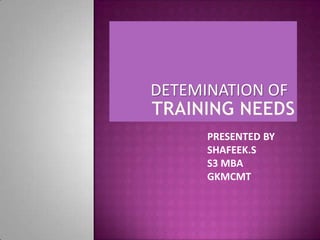
Identifying training needs
- 1. DETEMINATION OF PRESENTED BY SHAFEEK.S S3 MBA GKMCMT
- 2. According to Edwin.B.flippo “training is the act of increasing knowledge and skills of an employee for doing a particular job”. Training involves the development of skills that are usually necessary to perform a specific job. It should bring positive changes in knowledge, skills and attitude.
- 3. How to Determine Your Organization’s Training Needs • First, ask your workforce • Define your need area • Analyze and assess your current state. • Develop your plan • Engage experts. • Train your leaders first • Train your staff and institutionalize the training.
- 4. FIRST, ASK YOUR WORKFORCE. • Your front line employees, supervisors and managers live the day-to-day problems and challenge areas of your business. • Front line folks interact with your organization’s customers and must defend against your competitors. Because of their ground-level exposure, they can help you identify areas in which training is most needed. • Balance this input with what you learn from your industry’s associations and discussion boards, other senior leaders, your customers and your suppliers.
- 5. DEFINE YOUR NEED AREA • Once you believe you have identified a need area in which your organization should be trained or developed, define the need area with specifics • Training needs can be identified through following types of analysis. Organization analysis Task analysis Manpower or human resource analysis
- 6. ANALYZE AND ASSESS YOUR CURRENT STATE • Systematic study of organization in terms of its objectives, its resources, resource allocation and utilisation, growth potential and its environment • It’s purpose is to determine where training emphasis should be placed in the organization for increasing organizational effectiveness. • A good assessment should provide comparative norms against which you could benchmark your organization, and then measure individual’s progress following training.
- 7. Develop your plan • Effective training and development should change behaviors and performance, so it is never something into which to enter without a plan. • With Step 3’s benchmark in hand, establish your goals and objectives that describe where you want to be, and when you want to be there. • Determine the resources you will need. Think about what can go wrong during the execution of your plan and develop contingency plans. • Focus on measurable outcomes that result from employees successfully applying on what they have learned.
- 8. ENGAGE EXPERTS. • Face it – if you had the expertise in house already, then you would not have the gaps in performance, knowledge and/or behaviors! Instead, you need the expertise of outside resources with a proven track record of helping clients succeed. • The good ones will help you design your plan and may recommend assessments and tools that will help you benchmark and measure progress. • The best ones will help you to become self-sufficient (note to self: beware of those organizations that want to perpetually train you).
- 9. TRAIN YOUR LEADERS FIRST • Always train your leaders first. Leaders should model the new skills and behaviors themselves. And they must know the training well enough to accurately observe performance, reinforce the training, and coach employees who are trying to apply and master the training. • Effective leaders schedule observation time to follow up training, and have the necessary tools to provide formal and informal feedback to employees. • Unless management observation and feedback is intentional, what is learned will not be retained and the organization will have wasted the opportunity and resources spent on a training program.
- 10. TRAIN YOUR STAFF AND INSTITUTIONALIZE THE TRAINING. • The most effective training programs are those which follow this sage advice: Never do for the learner what the learner should do for himself. • The learner will only master a skill or behavior through repeated application. • Repetition is the heart of learning, so what is learned during the training must be reinforced in the days, weeks, and months following the training